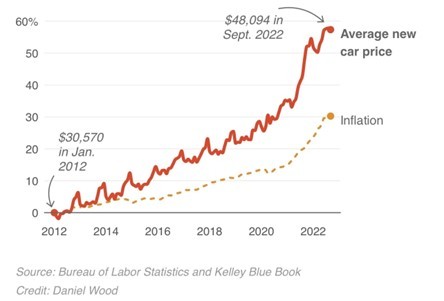
In recent years, the cost of buying a new vehicle has skyrocketed. Between 2012 and 2018, the average price of a new car went up by more than 20 percent! This trend is causing severe financial strain on consumers’ budgets and creating a ripple effect that is impacting auto dealerships across the country. Let’s take a closer look at why new car affordability is declining and how dealerships can help mitigate the problem.
Many households were left scrambling when a semiconductor shortage disrupted global inventories and extended wait times for months on end.
New vehicle manufacturers have been investing heavily in research and development to create cars with the latest technology and features. As a result, even entry-level vehicles now come equipped with advanced safety systems that adds extra cost that did not exist a few years ago.
Additionally, consumer credit scores have been trending downward since 2016 as debt levels rise, making it harder for buyers to qualify for favorable financing terms.
Despite these challenges, manufacturers are continually finding innovative solutions to deliver quality car models to customers quickly – all while maintaining price points that remain accessible even in this trying time!

The first step is to focus on cost-conscious options that don’t skimp on quality. Offering reliable cars with long-term warranties at lower price points can help customers purchase them without breaking the bank.
For many dealerships, offering flexible financing options is key to helping shoppers purchase vehicles within their budget. Offering longer terms or lower interest rates can make all the difference for someone who is struggling to afford their dream car.
Additionally, encouraging customers to trade in their old vehicles can help them save money by reducing their overall price tag and potentially lowering their monthly payments.
Educating customers about leasing versus buying may benefit those who are only looking for short-term ownership or don’t want to commit to a long-term loan obligation.
Transparency is essential when it comes to purchasing a new vehicle. Making sure buyers are aware of all fees – such as taxes, registration, and delivery charges- ahead of time can reduce any unwanted surprises or shock at checkout. This knowledge helps provide context for the overall transaction, so customers know exactly what they’re signing up for before committing!
The shift away from public transportation has led more people to purchase cars instead, creating unprecedented levels of demand that manufacturers have been unable to keep up with due to factory closures and supply chain disruptions caused by COVID-19 lockdowns around the world. Additionally, incentive programs offered by dealerships have further fueled demand despite higher prices resulting in even lower availability on the market overall. Automobile dealership managers should be aware of these trends when managing their operations so they can stay competitive within their industry.
